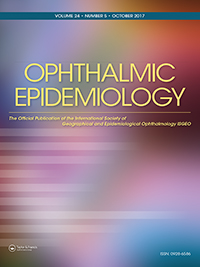Five-Year Incidence of Visual Impairment in Middle-Aged Iranians: The Shahroud Eye Cohort Study
Authors
Affiliations
1a Noor Ophthalmology Research Center, Noor Eye Hospital , Tehran , Iran.
2b Department of Epidemiology, School of Public Health , Shahroud University of Medical Sciences , Shahroud , Iran.
3c Department of Epidemiology and Biostatistics, School of Public Health , Tehran University of Medical Sciences , Tehran , Iran.
Abstract
Purpose: To study the 5-year incidence of visual impairment and its causes and risk factors, in the middle-aged Iranian sample of the Shahroud Eye Cohort Study (ShECS).
Methods: Data from subjects who had participated in both phases of the ShECS were used to determine age- and sex-specific incidence rates of visual impairment using the World Health Organization (WHO) definitions for bilateral low vision (visual acuity, VA, >0.5 and ≤1.3 LogMAR in the better eye) and blindness (VA worse than 1.3 LogMAR in the better eye). Risk ratios (RR) and 95% confidence intervals (CIs) were calculated using multivariable log-binomial regression.
Results: Of the 5079 ShECS I survivors, 4737 (93.3%) completed the 5-year follow-up. Their mean age at baseline was 50.9 ± 6.2 years, and 58.9% were female. The incidence of visual impairment was 1.12% (95% CI 0.82-1.42%) by presenting VA and 0.19% (95% CI 0.07-0.32%) by best-corrected VA; leading causes of the former were uncorrected refractive error (81.3%) and diabetic retinopathy (15.1%). In the multivariable model, risk factors for incident visual impairment by presenting VA were older age (RR 1.05, p = 0.044), lower education (RR 0.89, p = 0.002), and diabetes (RR 3.74, p < 0.001).
Conclusion: This is the first incidence study of visual impairment in a middle-aged Iranian population. Since age is a major risk factor, the number of visually impaired is expected to increase as the population ages, and less treatable causes such as diabetic retinopathy begin to surface. Measures for tackling uncorrected refractive error and enhancing diabetes screening and preventive programs are recommended.
Keywords: Blindness; Iran; incidence; longitudinal; visual impairment.

